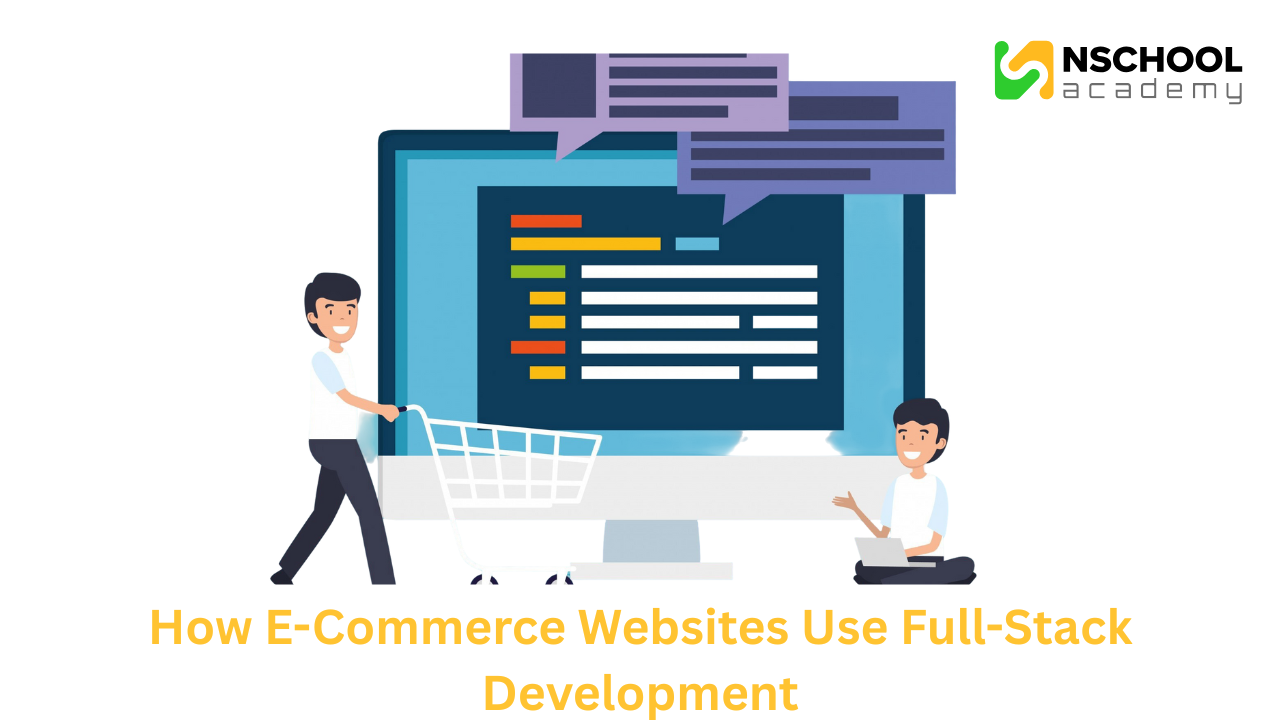How E-Commerce Websites Use Full-Stack Development
- June 10, 2025
- nschool
- 0

How E-Commerce Websites Use Full-Stack Development
E-commerce websites have changed how people shop by letting them browse, choose, and buy products anytime and from anywhere. From small local shops to big online stores like Amazon and Flipkart, e-commerce sites are everywhere. But do you know what technology makes these busy, interactive websites work? It’s called full-stack development — a skill that helps developers create and manage all parts of a website, including what you see and the behind-the-scenes work.
What is Full-Stack Development?
Full-stack development means working on both the front end and back end of a web application.
The front end is the part of the website that users view and use. It includes the look, layout, and how the site works when you click or scroll. Front end is made with tools like HTML, CSS, and JavaScript frameworks such as React, Angular, or Vue.js.
The back end is the part of the website you don’t see. It stores data, manages how the site works behind the scenes, checks user login, and connects the user’s browser to the server. Popular back-end tools include Node.js, Python, Ruby on Rails, PHP, databases like MySQL or MongoDB, and server management software.
A full-stack developer has the expertise to work on both layers and integrate them smoothly, creating a cohesive user experience.
Why Is Full-Stack Development Important for E-Commerce?
E-commerce websites are not simple static pages — they are dynamic, interactive platforms that must manage a variety of tasks, including:
- Displaying up-to-date product catalogs
- Managing user accounts and preferences
- Handling shopping carts and secure checkouts
- Processing payments and managing inventory
- Providing customer support and notifications
Full-stack development is important because it helps developers create complete solutions that work well from start to finish. When developers know full-stack skills, they can build systems that grow easily, provide a good experience for users, and keep data safe.
Key Components of How E-Commerce Websites Use Full-Stack Development
Let’s break down the main features of an e-commerce website and see how full-stack development supports each.
1.Product Catalog and Search
Front End: The website shows products with pictures, descriptions, prices, and reviews. Users can quickly sort products by category, price, or rating using JavaScript features.
Back End: Product details are kept in databases like MongoDB or MySQL. The server searches the database and sends matching products to the front end when users look for something.
For example, if you search for “wireless headphones,” the backend finds products with that name and shows them on your screen.
2.User Login and Profiles
Front End: Users can sign up, log in, reset passwords, and change their profile information using simple and clear forms.
Back End: The back end keeps user information safe by encrypting passwords and managing login sessions. It uses tools like JWT (JSON Web Tokens) to check users without revealing private data. It also helps with password recovery and extra security steps like multifactor authentication.
Social logins like Google or Facebook are added here to make logging in easier.
3. Shopping Cart and Checkout Process
Front End: The cart lets users add or remove items, change quantities, see the total cost, and enter shipping and payment details easily.
Back End: This part handles the main work. It calculates the final amount, adds any discounts or taxes, checks if items are in stock, and creates the order. It also connects with payment systems like Stripe, PayPal, or Razorpay to process payments safely.
The backend updates the stock in real time, so products don’t get oversold.
4. Order Management and Notifications
Back End: After a customer places an order, the server tracks it—from processing to delivery. It also handles returns and refunds, storing all the order details in the database.
Front End: Users can check their order history, see where their order is, and get updates through email or app notifications.
5. Admin Dashboard
- Full Stack: Behind every e-commerce website is an admin panel that allows store owners or managers to:
- Add or update products
- Manage categories and pricing
- Monitor sales and customer activity
- Handle customer support tickets
- Add or update products
This dashboard is typically built with the same full-stack technologies and requires both front-end UI and back-end business logic.
Popular Full-Stack Technologies Used in E-Commerce
Front-End
- React.js: A popular JavaScript library for building fast and interactive user interfaces.
- Vue.js or Angular: Alternative frameworks with similar purposes.
- CSS3 & HTML5: For layout and design.
Back-End
- Node.js with Express.js: JavaScript runtime and framework for building scalable server applications.
- Python with Django or Flask: Python-based options for rapid development.
- Databases: MongoDB (NoSQL) or MySQL/PostgreSQL (SQL) to store products, users, and orders.
Payment Gateways: Stripe, PayPal, Razorpay APIs to process payments securely.
Why Learning Full-Stack Development Is a Smart Career Move in 2025
Full-stack development is becoming more popular every year, especially in fast-growing countries like India. Many companies are looking for skilled developers who can work on both the front-end (what users see) and the back-end (how things work behind the scenes). Hiring full-stack developers helps businesses save time and improve teamwork, which leads to faster product launches.
E-commerce is also growing quickly. Every year, thousands of new online shops are created. If you know how to build and manage these websites, you will have more job opportunities and stand out in the competitive information technology field.
Conclusion:
E-commerce websites are a great example of how full-stack development connects design, functionality, and business processes to create smooth online shopping experiences. From showing products to managing payments and orders, every step depends on full-stack technologies working together.
If you’re interested in web development and want to create projects that make a real impact, learning full-stack development is a smart move. It gives you the skills to build complete web applications and opens the door to many exciting career opportunities in the IT field.

